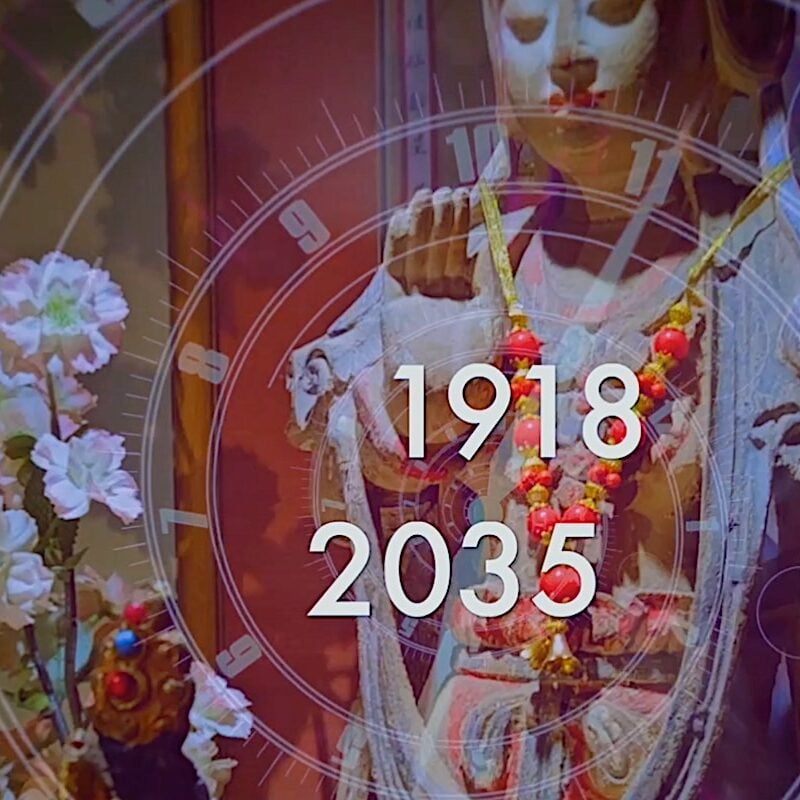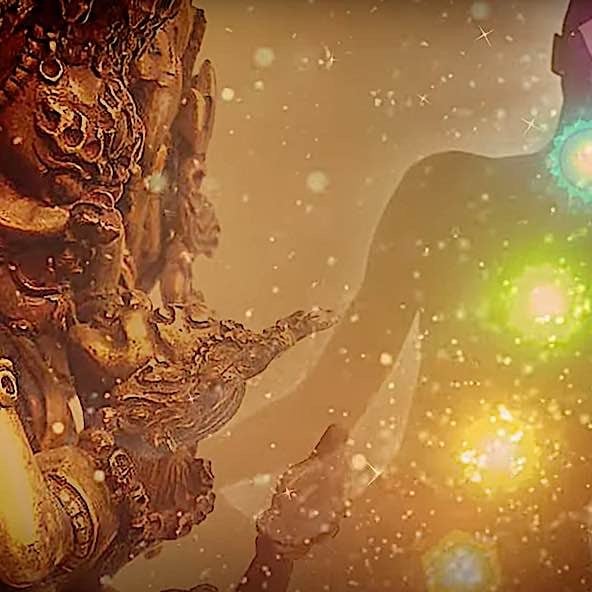Buddha on Dharma Prayer Wheels: “defilements will be purified and the face of the deity will appear”; Guru Rinpoche: you will “be able to attain mystic powers…”
It’s unlikely you’ll be levitating off the ground any time soon — even if you undertake millions of prayer wheel spins — so what did the great Guru Rinpoche Padmasambhava mean when he wrote: you will “be able to attain mystic powers… eliminate immeasurable karmic obscurations” in teachings on Prayer Wheels? We can only guess — Guru Rinpoche was fully Enlightened; we are not. However, a review of five separate sacred texts on Prayer Wheels, from elites such as the fourth Panchen Lama, and other great Gurus, states similar benefits. For example, Lama Zopa Rinpoche, in an introduction to a translation on several Prayer Wheel texts writes [1]:
“Turning the prayer wheel once is the same as having done many years of retreat.”
Although this begs the question, “Why engage in a three-year retreat, when you could just sit and spin a Dharma Wheel?” — that’s not the point. It’s not permission to be lazy. It’s permission to practice everywhere, more often, for the benefit of all sentient beings. This is why you see great teachers such as H.E. Garchen Rinpoche, at a Highest Yoga Tantra commentary on Vajrayogini, spinning the prayer wheel as he speaks. The spinning doesn’t ever stop — for the benefit of all sentient beings.
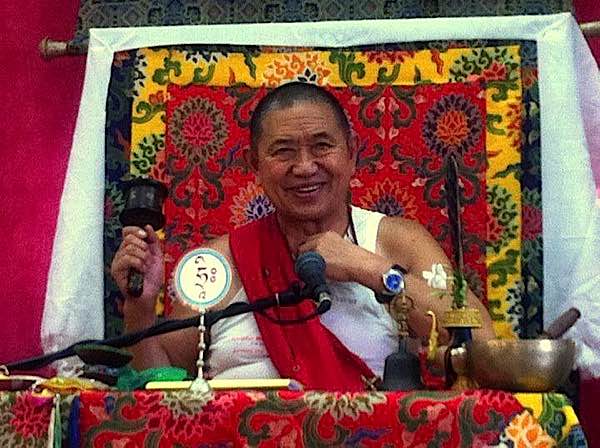
Prayer Wheels are for all levels of practice
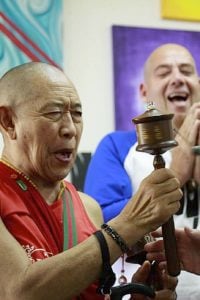
Prayer Wheels are sometimes thought of as a “beginner” practice; however, quite the opposite is true. Yes, anyone can practice, but the more advanced the practitioner, the greater the benefit. In an important text, “Benefits of the Lotus Wheel”, by the teacher Rinchen Nampar Gyalwa, the “everywhere” aspect is emphasized — and here the author is quoting the Buddha, responding to Shariputra:
“For those who turn the lotus wheel… during the times of the great festivals, but also daily, it is like the continuous flow of an unobstructed river. For those sentient beings in the three lower realms the turning churns them up from the depths… if the yogic practitioner turns, the two aims will be instantaneously accomplished. If a monk turns the lotus wheel, all vows will be renewed. If a tantric practitioner turns the Lotus Wheel, the defilements will be purified and the face of the deity will appear. If a healer turns the lotus wheel, all illnesses will be cured…”
If so, then, why engage in, for example, advanced Phowa practice, when the sacred texts say you can place the prayer wheel at the head of a dying person with the same effect? In that case, the answer might be Phowa practice can be difficult for someone in pain who is passing away. Then, why retreat to a cave for three years, when you could sit in the comfort of home with a prayer wheel? Of course, the obvious answer is that the practices are different and complimentary.
The prayer wheel is NOT about “loafing off” in practice. It is about providing meaningful opportunities to practice more often — not less often — and with more “multiplied” effect — and to engage in Compassion (Metta), Karuna (Loving Kindness) and Bodhichitta everywhere. Even sitting in front of the TV, or chatting on Facebook can become opportunities to practice if you have a handy prayer wheel.
But, aside from we lazy Netflix fans and Facebook junkies, who might benefit from a little spinning, its clear from the texts, that the more advanced the practitioner, the more profound the impact:
- Tantric practitioners “the deity will appear”
- Yogic practitioners “two aims will be instantly accomplished”
- Monks, “vows will be renewed”
- Healers, “all illnesses will be cured.”
Temples all around the world have giant prayer wheels with tens or hundreds-of-millions of mantra:
For this reason, a Highest Yoga Tantra practitioners might spin the wheel while reciting mantras during an intense visualization practice. Yogis might spin the wheel “attracting the Dakinis and Protectors” and gaining help attaining the two accomplishments. Monks can purify serious breaches of vows. And everyone could use a little healing.
Lama Zopa writes, “When reading of the benefits, it may also be helpful to reflect that many human beings do not have the opportunity, the karma, to even see a holy object, such as a statue of the Buddha, in their whole life… So those who get this precious opportunity are very few… so to engage in this practice, and have faith in its benefits… is the easiest way to purify all negative karmas.”

The highest of protections simplified
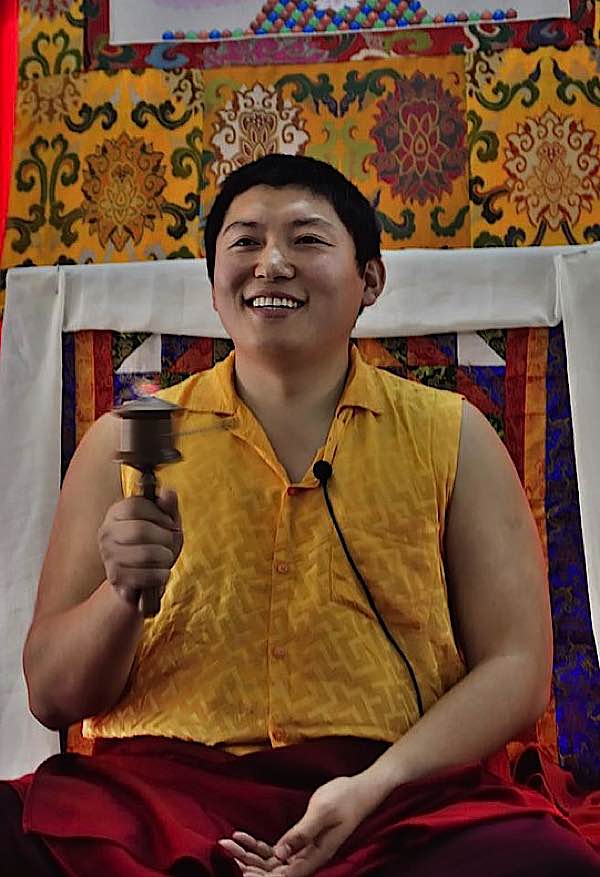
At risk of over-simplifying, the gist of why the seemingly “simple” practice of Dharma Wheel is of such vast benefit lies, in part, in its — simplicity. There are other compassion practices, but the Prayer Wheel [Dharma Wheel, Mani Wheel] practice is instantly mastered, can be practiced anywhere and everywhere, and involves all of your Body, Speech and Mind. Spinning the wheel (body and activity) of millions of mantras inside (Speech) and visualizing purification and healing for all sentient beings (Mind.)
The famous Lama Gungtangpa (1762-1823) explained the benefits in “A short treatise on Prayer Wheels”. From the ancient translations:
“It is the highest of protections and it cuts off rebirth of the six types, it purifies the three transitional states, and, the spinning is of even greater purity than, the mantra recitation itself; the benefits likewise are much greater.”
Spin anywhere, anytime
Waiting in line? On a coffee break at work? Sitting at home with the power out due to the latest snow storm? Pull out your portable Dharma Wheel and spin. (Today, Mani Wheels are made in many formats and styles: tiny pendant spinners (with thousands of mantras), small, medium, large and massive hand spinners, table wheels, water wheels, wind wheels, to giant temple-sized wheels with hundreds-of-millions. Portable prayer wheels, small enough for a purse, man bag or shoulder bag are available, and with almost any mantra. In ancient Tibet, farmers used to plow their fields while spinning their Mani Wheels, and people carried their wheel with them to the market, to work, almost everywhere.
Although it doesn’t eliminate the benefit of ritual, candles, incense, sadhana — it’s a handy “booster” that can stand-in when you’re in a hurry, or “multiply the benefit” in a long mantra session. Yet, as Lama Zopa says, “millions of mantras of Compassion” sent out with intention to billions of sentient beings, and an instant transformation to “peaceful, pleasant, and conducive to the mind.”
What could be more deal for those struggling with higher practices (for example, being unable to fit in the hour-long sadhana) — those with limited time, busy lives, and those who engage in Bodhichitta, Metta and Karuna practices. That’s pretty well all of us (at least, most Mahayana Buddhists.) This is why you see many of today’s teachers, and notably H.E. Garchen Rinpoche, with prayer wheels in hand. It may be ubiquitious, common and easy, but that doesn’t make it less effective.
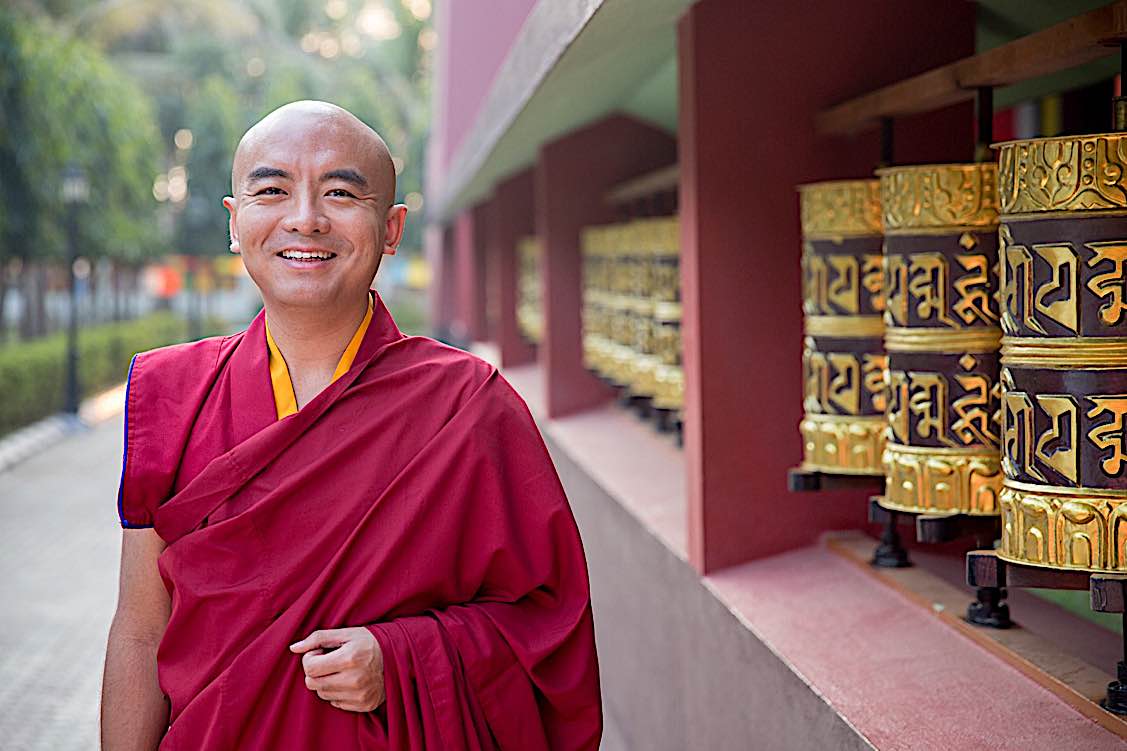
Ultimate Compassion Practice
Prayer Wheels are, you could say, the ultimate Compassion practice. The entire practice, visualization, recitation is focused on benefiting other sentient beings. Of course this has vast merit in Mahayana Buddhism — where Compassion and Wisdom are the two wings. If Prayer Wheels are all about compassion, what about Wisdom? Is there an easier way to focus on Shunyata and mindfulness than on simply “spinning?”
It’s easy to analyze this and assume, “oh, the great teachers say that because it’s better to do a simple practice daily and perfectly, than to give up on a higher meditation you can’t master.” But, it’s not that simple (pun intended.) Prayer Wheels get a bad rap that way. They’re not simple tools for non-Dharma practitioners who are busy with mundane lives and can’t focus on a long mantra retreat. Their practice may seem simple, but there’s a sophisticated elegance that is often missed. There’s nothing sophisticated about a practitioner with dozens of Higher Yoga initiations, who never finds time to master them.

Benefits are extensive; practice is elegantly simple
“To many pratitioners, mantra recitation, mala, retreat and visualization are the ultimate practice — especially for those who practice Highest Yogic practices. Yet, according to many great teachers — from Padmasambhava Guru Rinpoche, to the fourth Panchen Lama, to long lineage of great teachers — the practice of spinning the Dharma or Mani Wheel is more effective than recitation alone. It has been called the ultimate “Bodhichitta” practice, since it’s intention is entirely about benefiting all sentient beings.

Using the colourful language of the texts, Amitabha said, “Anyone who recites… while turning the Dharma Wheel a the same time is equal in fortune to the Thousand Buddhas.” This is colourful English translation, meant to convey the vast benefit.
The great Guru Rinpoche — who brought us lineages of advanced Yogic practices — explains the benefit of Dharma Wheels this way: “even those lacking perserverance in their practice, who pass the time passively, will be able to attain mystic powers. Those with perseverance for reciting the mantra and turning the wheel will undoubtedly attain the tenth bhumi; it instantly eliminates all the immeasurable negative karmic obscurations. Whatever Yidam you wish to practice will be achieved simultaneously.”
Is it just because Higher Practices often take a lifetime to master (or several lifetimes), while the profoundly simple and effective Dharma Wheel practice can be started today, with benefits for all sentient beings immediately? It’s clearly more than that. Like mindfulness meditaiton — which is easy to explain, yet so hard to practice — Dharma Wheel practice is complete and sophisticated.
This is why you see teachers spinning Prayer Wheels even at Higher Yogic retreats as they teach. For instance, in this wonderful commentary on Vajrayogini, a Highest Yoga Tantra practice, notice that H.E. Garchen Rinpoche never stops spinning the wheel, even though the teaching is days-long. [See picture below, and video embedded.]

Prayer Wheels may be the ultimate Bodhichitta practice
According tob all the great teachers and many translated texts, the benefits or turning the wheel are greater than mantra recitation alone. Keeping your prayer wheel by your side is well advised.
Lama Zopa Rinpoche, who is a strong advocate of Mani Wheels, once told the Napalese King, “if you have this prayer wheel next to you at the time of death, then your consciousness will be reborn in the Pure Land of the Buddha.”
It is, perhaps, no wonder, that you see traditional Tibetans turning the wheel even as they walk down the street. H.E. Garchen Rinpoche famously spins a prayer wheel almost everywhere, even at formal teachings. Temple and centre large prayer wheels are popular — and in pilgrimage areas can have a line up.
Video of H.E Garchen Rinpoche teaching a Vajrayogini retreat:
How to Practice the Dharma Wheel
Just spin! (Clockwise! Most texts and teachers specify spinning clockwise.)
This is the simplest practice. If you are spinning while doing other things — such as H.E. Garchen Rinpoche when he is teaching — this is still of benefit. It’s multitasking for the benefit of all sentient beings.
Are you planning a mantra retreat, either working or more intense? Ask your teacher if it is a good idea to spin with one hand while working the mala with the other during some of the recitations. [Author’s note: for me, it really aided my focus when reciting mantras for hours.]
Squeeze in spinning any chance you get at home, or outside the home (if you have a portable spinner or a pendant spinner.)
For formal practice, there are, of course, methods in the texts — to which we would refer you to the excellent text The Wheel of Great Compassion: the Practice of the Prayer Wheel in Tibetan Buddhism edited by Lorne Ladner, Ph.D. (Wisdom Publications.)
Lama Zopa Rinpoche recommends a thousand mantras a day as a good guide. He advises each set of 100 spins be dedicated to the merit and benefit of a group of beings. For example, 100 for humans. Another 100 for animals, especially focusing on those who are hunted and slaughtered. You could even decdicate a hundred to your own practice, another 100 to healing, another 100 to removing specific obstacles. Intention is important.
As with all Buddhist practices, it is best to start with Taking Refuge in the Three Jewels and ending with a dedication for the merit of all sentient beings.

Practicing Compassion: Om Mani Padme Hum
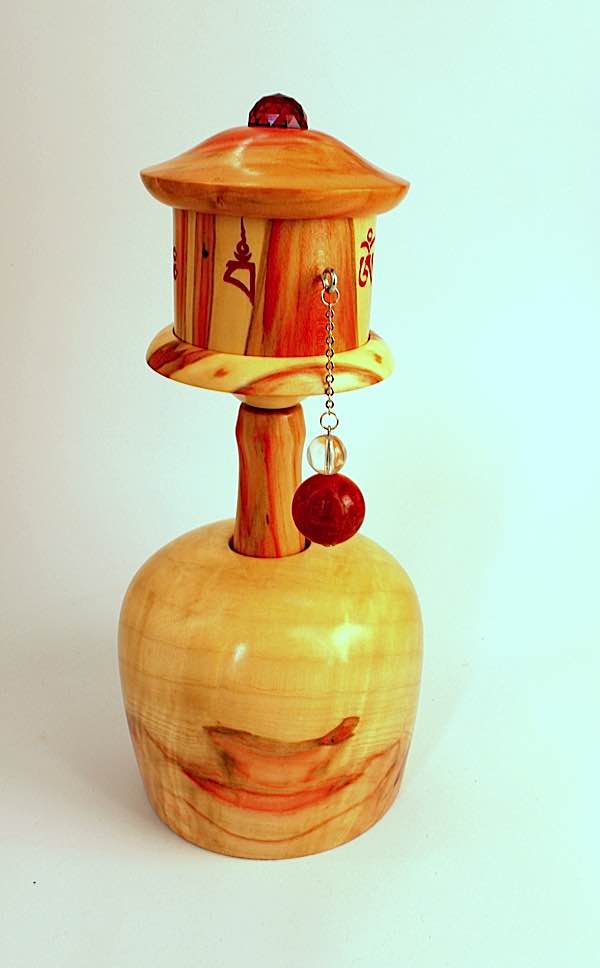
The entire practice, a complete Body, Speech and Mind practice, includes the physical act of spinning (Body), the mental aspect of visualizing (Mind: imagining healing light going out to all beings) and voice (Dharma) — both actually spoken, if recited, and in the form of millions of mantras inside the wheel. More importantly, each of those activities is dedicated to the benefit of all beings. The wheel rotates millions of mantras (depending on the size, it could be hundreds-of-thousands, or even hundreds-of-millions in the temple wheels — sending out the Mantra’s blessings.
If you’re spinning as formal practice, the student is also visualizing the mantras and healing light going out to all beings in the Universe — every single sentient being. Unlike other practices, such as Deity Practice, or Vipassana, whose purposes are more about the self-development — which is turn is dedicated to the future benefit of all sentient beings — you could say that Prayer Wheel practice is for the immediate benefit of others, rather than self. Yes, there are significant benefits to the self, in the form of good Karma and merit, but it’s all about Compassion. For this reason, one name of the wheel is the Mani Wheel, and the most popular mantra inside is
Om Mani Padme Hum
Today, however, mantras of all types, from the simple profound — Om Ah Hum — to the complex and specific (mantras of Higher Yogic Tantric Deity aspects) are found in prayer wheels (see links below for more on this.)
According to Lama Zopa, H.H. Dalai Lama, Geshe Rabten Rinpoche (a great yogi and scholar) and other great teachers have personal prayer wheels. A big advocate of their use was H.H. Trijang Rinpoche — the root guru of many Gelug lamas, including Lama Zopa, Zasep Rinpoche, and many others — who was also an early tutor of the Dalai Lama.
Although we have previously written about Prayer Wheels — in great detail — (several links below), this feature is from the point of view of the English translations of traditional Tibetan texts from Padmasambhava and other great teachers, on the practice of Dharma Wheels, as gathered in the wonderful modern book The Wheel of Great Compassion. [1]
Previous Stories on Dharma Wheels in Buddha Weekly
- Wheel of Dharma: Why Prayer Wheels May be the Ideal Practice for Busy People>>
- Prayer Wheels Growing in Popularity; Benefiting Sentient Beings>>
- Inspired by H.E. Garchen Rinpoche, Galgamani Art Project Aims to Personalized Tibetan Prayer Wheels>>
NOTES
[1] The Wheel of Great Compassion: the Practice of the Prayer Wheel in Tibetan Buddhism, with translations by Lama Thubten Zopa Rinpoche, Lori Cayton, Khamlung Tulku, Dan Martin, Milson Hurley, Yeshe Kedrup; edited by Lorne Ladner, Ph.D. (Wisdom Publications.)
- Paperback: 168 pages
- Publisher: Wisdom Publications; 1 edition (January 15, 2001)
- Language: English
- ISBN-10: 0861711742
- ISBN-13: 978-0861711741
More articles by this author

Who is my Enlightened Life Protector Based on Tibetan Animal Sign Zodiac in Buddhism? According to Mewa, Mahayana tradition and Kalachakra-based astrology (with Mantra Videos!)
Search
Latest Features
Please support the "Spread the Dharma" mission as one of our heroic Dharma Supporting Members, or with a one-time donation.
Please Help Support the “Spread the Dharma” Mission!

Be a part of the noble mission as a supporting member or a patron, or a volunteer contributor of content.
The power of Dharma to help sentient beings, in part, lies in ensuring access to Buddha’s precious Dharma — the mission of Buddha Weekly. We can’t do it without you!
A non-profit association since 2007, Buddha Weekly published many feature articles, videos, and, podcasts. Please consider supporting the mission to preserve and “Spread the Dharma." Your support as either a patron or a supporting member helps defray the high costs of producing quality Dharma content. Thank you! Learn more here, or become one of our super karma heroes on Patreon.
Lee Kane
Author | Buddha Weekly
Lee Kane is the editor of Buddha Weekly, since 2007. His main focuses as a writer are mindfulness techniques, meditation, Dharma and Sutra commentaries, Buddhist practices, international perspectives and traditions, Vajrayana, Mahayana, Zen. He also covers various events.
Lee also contributes as a writer to various other online magazines and blogs.










